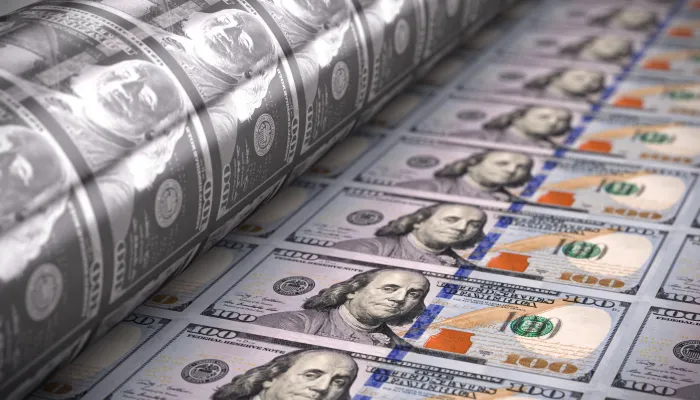How Much Will Trump’s New Tariffs Raise?
On April 2, the Trump Administration announced a series of so-called "reciprocal tariffs” applied to nearly every country with which the United States trades. On a conventional basis, we estimate the reciprocal tariffs could generate roughly $100 to $200 billion through the rest of Calendar Year (CY) 2025 if they remain in place and $1.8 trillion through Fiscal Year (FY) 2034 if they are made permanent. We roughly estimate that the tariffs could also reduce output by about half a percent on a sustained basis – before considering the effects of a loss of market confidence due to the trade war – which would reduce their revenue impact by about 14 percent.
Revenue Impact of Trump's Enacted Tariffs
| Policy | 2025 (Assumed Temporary) |
2025 (Assumed Permanent) |
FY 2025-2034 (If Made Permanent) |
FY 2025-2034 (Dynamic) |
|---|---|---|---|---|
| Tariffs | ||||
| April 2 "Reciprocal Tariffs" | $100 billion | $200 billion | $1.8 trillion | $1.6 trillion |
| All Announced Tariffs | $150 billion | $300 billion | $3.0 trillion | $2.7 trillion |
Sources: Committee for a Responsible Federal Budget estimates mainly based on data from the Congressional Budget Office (CBO) and U.S. Census Bureau.
Notes: Numbers are rough and rounded. Conventional estimates reflect the average of scenarios where lost trade is and isn’t diverted to other trading partners. Conventional estimates assume tariffs would reduce import levels consistent with elasticities derived from research and that all gained tariff revenue would be subject to income and payroll tax revenue offsets. For diversion estimates, diverted imports are subject to elasticities to the degree that tariffs on imports from other countries have also risen. Impacts on the economy are roughly created using CBO estimates as a reference, and the resulting revenue impacts assume GDP losses are due to productivity losses.
President Trump’s enacted “reciprocal tariffs” are not based on foreign nation’s tariffs but instead on the bilateral trade deficit between the U.S. and each respective nation. Specifically, the Administration estimates the tariff level they believe would bring trade between two countries into balance – using a formula that is understood more simply to be the equivalent of dividing the bilateral trade deficit by imports from the country – and then cuts that rate in half.
These tariffs are subject to a 10 percent floor and reach as high as 50 percent. They are in addition to existing tariffs. Some goods are exempt from the reciprocal tariffs, such as steel, aluminum, autos and auto parts, copper, pharmaceuticals, semiconductors, and lumber.
If consumers and businesses view these tariffs as temporary, we estimate they would generate about $100 billion through the rest of 2025 on a conventional basis – before considering macro-dynamic effects on the rest of the economy – as a significant amount of consumption and investment would be deferred. If the tariffs are viewed as permanent, we estimate they would generate $200 billion instead. And if the tariffs were made permanent, we estimate they would generate $1.8 trillion through FY 2034.
Although significant revenue can be derived from tariffs, tariffs are also likely to increase prices and reduce output, and the negative economic consequences associated with tariffs can lower expected revenue. While there is general agreement among most experts that large increases in tariffs will negatively impact the economy, there remains great uncertainty around the degree of economic impact. We roughly estimate that these tariffs will lower real GDP by half a percent on a sustained basis, which aligns with other estimators, reducing the dynamic revenue collection to $1.6 trillion through FY 2034, if made permanent.
However, the negative economic feedback could be significantly larger if tariffs lead to a recession, economic warfare, or loss of confidence by markets. With various institutions stating there is heightened risk of recession in the near term, one-year revenue estimates could potentially be negative after dynamic effects.
The reciprocal tariffs also come on top of other recent tariffs, including a 20 percent tariff on Chinese goods, 10 to 25 percent tariffs on Canadian and Mexican goods, 25 percent tariffs on automobiles, and 25 percent tariffs on steel and aluminum.
In total, we estimate that the average weighted tariff rate on imports will rise to roughly 21 percent, much higher than the world’s average tariff rate of about 5 percent on U.S. goods. Over time, we expect the 21 percent weighted average tariff rate to decline as trade flows to lower-tariff nations or is replaced by domestic production.
We conventionally estimate all tariffs combined will raise $150 to $300 billion through the rest of CY 2025, depending on if the tariffs are viewed as temporary or permanent, or $3.0 trillion through FY 2034 if permanent. These tariffs could reduce real GDP by 0.6 percent, decreasing our permanent estimate through FY 2034 to $2.7 trillion under dynamic scoring. Importantly, the dynamic effects could be much larger than estimated here and result in one-year revenue being much lower – perhaps even negative – as well as significantly lower cumulative revenue through 2034.
Importantly, our estimates are very rough and intended to reflect the general magnitude of the policies rather than precise scores, given the complexity of the tariffs and their impacts. This is especially true for estimates that incorporate dynamic and retaliatory effects on revenues, which we roughly create using estimates by the Congressional Budget Office as a reference.
Ten-Year Scores of Trump's Tariffs, If Made Permanent
| Policy | Conventional | Dynamic |
|---|---|---|
| Reciprocal Tariffs | ||
| CRFB | $1.8 trillion | $1.6 trillion |
| Tax Foundation | $1.5 trillion | $1.2 trillion |
| Yale Budget Lab | $1.4 trillion | $1.0 trillion |
| Reciprocal & All Other Tariffs | ||
| CRFB | $3.0 trillion | $2.7 trillion |
| Tax Foundation | $2.9 trillion | $2.3 trillion |
| Yale Budget Lab | $3.1 trillion | $2.5 trillion |
Sources: Committee for a Responsible Federal Budget, Tax Foundation, Yale Budget Lab.
Note: Numbers are rounded.
Although our estimates are rough, they are similar to those recently published by Yale Budget Lab and Tax Foundation. Our conventional estimates of the reciprocal tariffs appear to be higher than these organizations, likely due to differences in incorporating exempt goods and other differences in modeling. However, there is general consensus that the net revenue gain from all of President Trump’s tariffs is roughly $3 trillion on a conventional basis over ten years (assuming the tariffs are permanent) and much less after dynamic effects.


